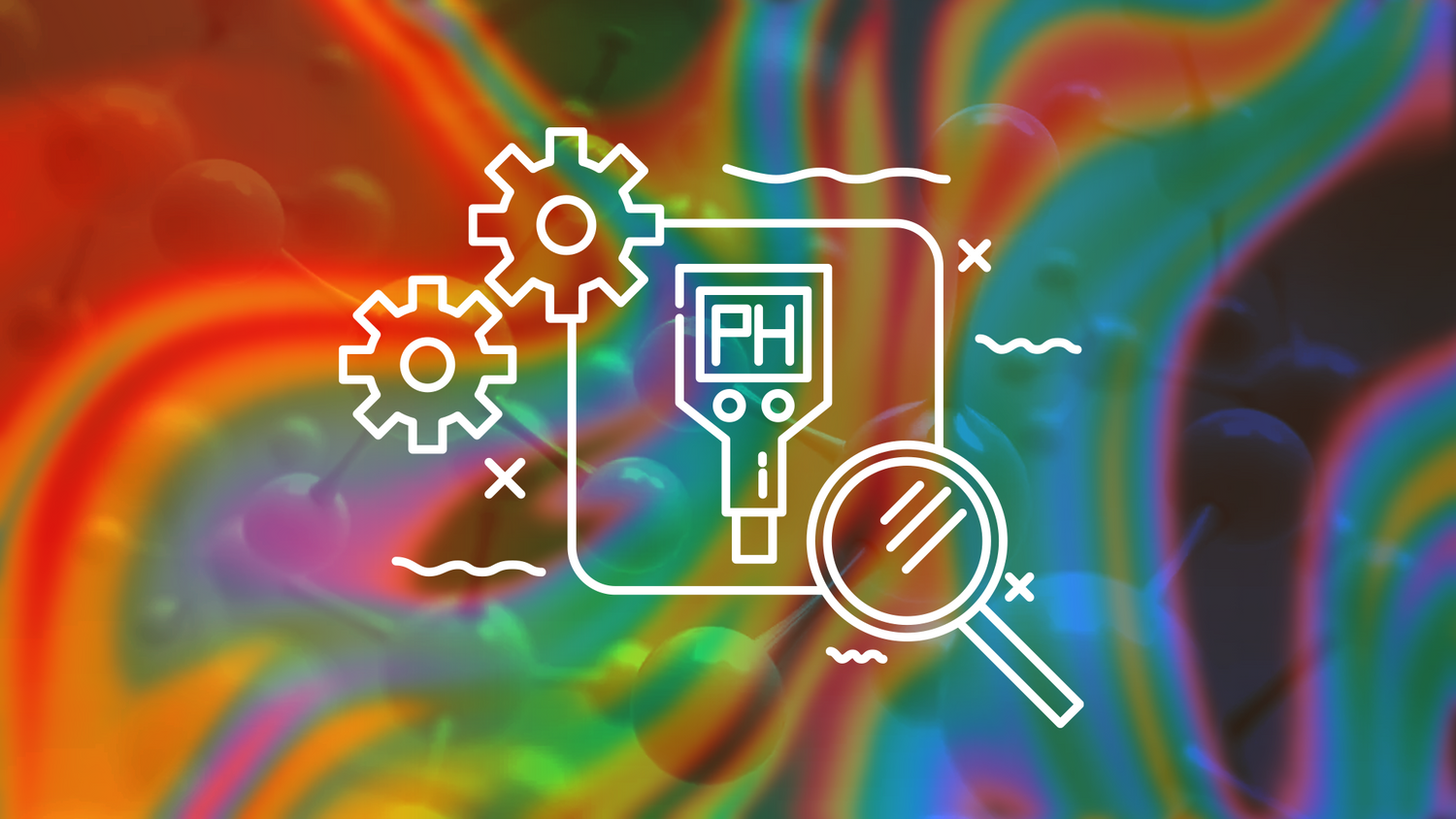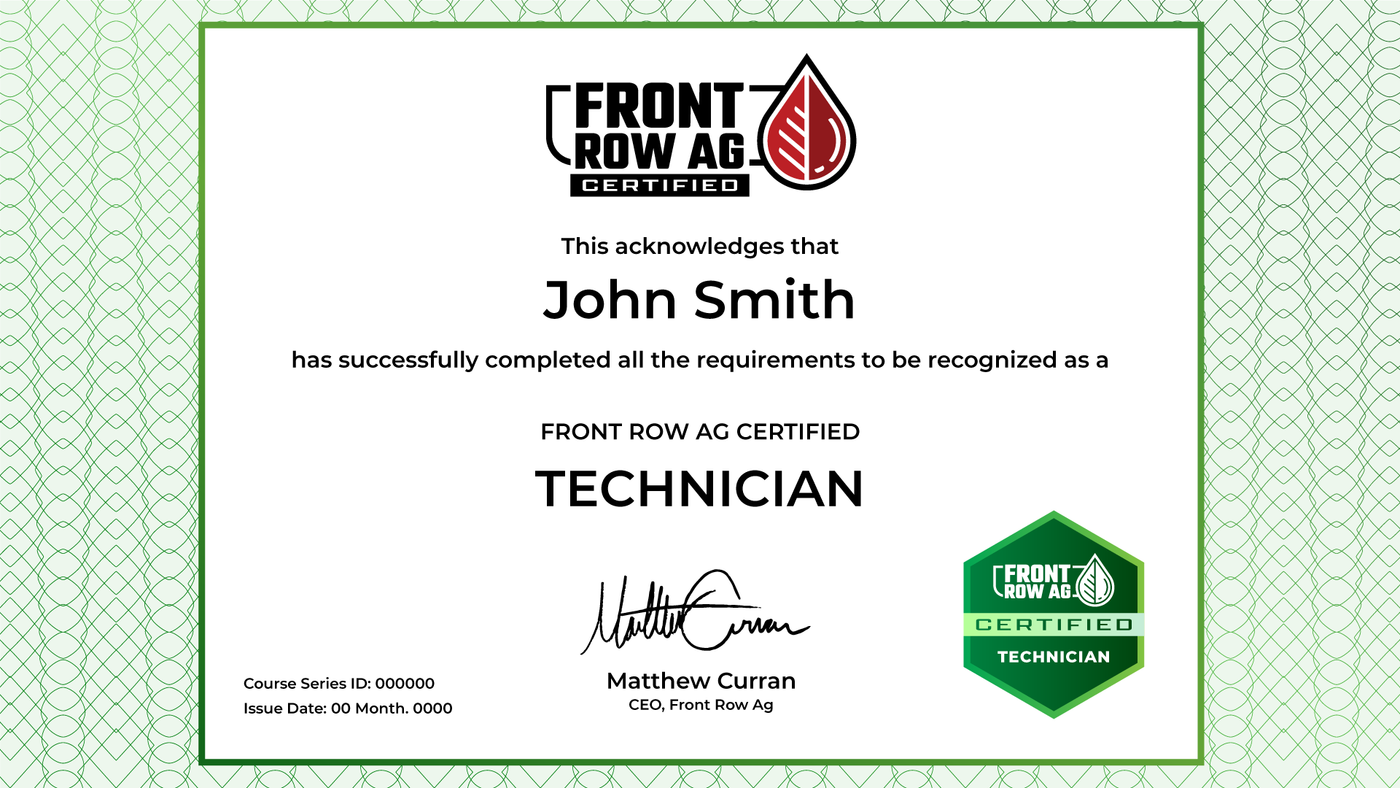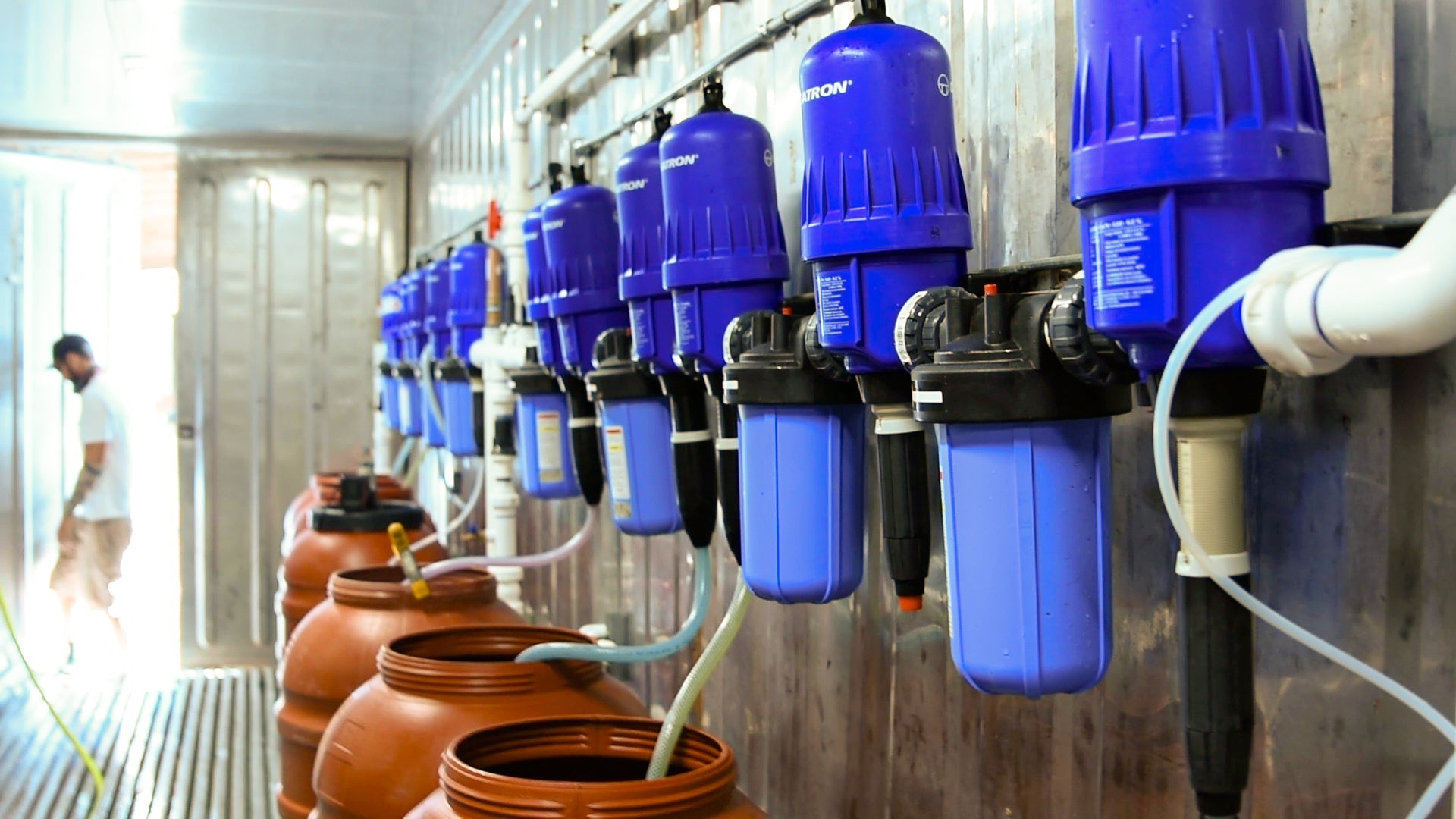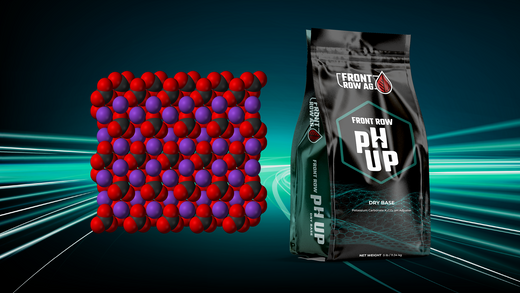Introduction: pH in Practice
In Controlled Environment Agriculture (CEA), managing the pH of nutrient solutions is a fundamental aspect of ensuring optimal plant health and growth. This article focuses on the importance of adjusting pH levels in facilities using low EC water sources like Reverse Osmosis (RO) or rain catchment systems, as well as those with higher EC city or well water. The article discusses choosing and using common bases and acids for pH adjustment, including Potassium Hydroxide, Potassium Carbonate, Phosphoric Acid, and Sulfuric Acid. It also covers the sequence of adding pH adjusters in fertigation systems and the importance of accurate pH measurement and calibration.
Raising pH
This is generally required for facilities using very low EC water from Reverse Osmosis (RO) or rain catchment, due to low levels of preexisting alkalinity. The low buffering capacity that results from lack of alkalinity means that these water sources will be very sensitive to the pH effects from fertilizer and pH adjusters.
These facilities will need to use one of the common bases to raise the pH of their fertilizer solution:
- Potassium hydroxide (KOH) - This is a strong base that exerts large and immediate changes to solution pH. While this can be desirable in some situation, it’s very important to dilute it, then add it very gradually to not cause unfavorable interactions. Note that it does add some potassium to the final solution.
- Potassium carbonate (Front Row Ag Clean Up) - This base is milder and safer than KOH, causing a slower change to pH while adding some buffering capacity that stabilizes the solution from future pH drift. For many applications these qualities are highly desirable, however it’s important to know that the adjustments require up to 15 minutes to fully take effect; a common mistake is over-application due to measurement before this occurs. Due to it’s lower reactivity, it can be added directly to the reservoir in powdered form, or diluted at 20-40 g/gallon and injected.
Lowering pH
This is usually required with city and well water that’s naturally higher that 0.2 EC, due to high levels of alkalinity present, generally in the form of carbonates. The higher the EC of the starting water, the higher the required usage rate of pH down will be with these water sources.
Facilities using these water sources will need to use one of the common acids to lower the pH of the fertilizer solution:
- Phosphoric Acid - This is the most frequently used pH down product for hydroponics, this is a strong acid that exerts large and immediate effects on pH.
- Sulfuric Acid - Another good option; especially because it doesn’t add any NPK ions that would throw off the ratios of the fertilizer solution. However, it’s extremely caustic so as with all pH adjusters, handle with care and use appropriate PPE like safety glasses and gloves.
- Organic acids - These are weak acids, like citric or acetic acid. As discussed in previous articles, we don’t recommend these as their effects are inconsistent due to how they can be metabolized by microbes over time these over time, resulting in major pH swings and potential biofilm buildup.
Injection Sequence
Setting up the proper initial injection sequence is crucial to consistent operation and minimizing adverse reactions. While there are several ways that can work, we recommend using the pH adjuster last in the injection order.
This is especially important with pH up; most quality fertilizers are acidic so if the necessary quantity of pH up is added before the fertilizer, the adjusted water that hits the first fertilizer injector can be quite high in pH. This high pH water reduces the solubility of several minerals and can even result in precipitation (fall out) in the fertigation system. This is avoided by adding pH up last, so that the fertilizer is already mixed into highly soluble, low pH solution, before having the pH returned to the ideal target.
Measuring pH - “when” and “where” matters.
We commonly see problems, especially over-application of pH adjusters, due to lack of knowledge around pH measurement. Fertigation panels often have inline pH measurement directly at the exit of the dosing panel. This is problematic; measuring pH immediately after adding the pH adjuster or directly at the exit of the fertigation panel can be misleading as it will not have had time to fully mix or for the reaction that raises/lowers the pH to complete. It’s common to get a false reading at this point, as the pH can continue to shift for several minutes depending on the chemical used and mineral composition of the fertilizer.
Instead, we recommend measuring the pH in one of the following ways:
- In the batch tank after 5-15 minutes mixing time (depending on the chemical used).
- At the plant site, in a collection cup that captures nutrient solution at the dripper.
Additionally when measuring pH, always use a pH meter that has been recently calibrated and validated. This technology is quite sensitive and can give misleading results if probes have been allowed to dry out or become dirty. We recommend calibrating at least once per week.
Adjustments to pH at the dosing panel should be quite small if the initial usage rate is determined accurately via a bucket test.
Determining initial usage rates (bucket tests)
Performing a test to determine the initial pH adjuster usage rates for your facility can prevent a lot of problems. The best way to do this is what we call a “bucket test”. This involves using a 5 gallon bucket filled with un-pHed nutrient solution at a typical EC for your facility, then incrementally adding very precise quantities of pH adjuster until you hit your target pH.
We recommend this for determining the approximate amount of pH adjuster required, then setting your injector (or noting your direct-to-reservoir rate) for that. This example will use CleanUp for raising the pH of fertilizer solution mixed into RO, using a D14MZ2 doser:
- Start with a 5 gal bucket of un-pHed fertilizer solution,
- Add CleanUp in increments of 0.05 g/gal (so 0.25 grams per addition for 5 gallons).
- In between each addition, mix for 15 minutes then test the pH.
- When you've achieved your target pH, note the total amount of CleanUp required (e.g. if it took three additions, that would be 0.15 g/gal).
- Set your doser (based on your stock concentrate) to inject that amount per gallon (e.g. 0.65% in this example: 0.65% x 23 g/gal concentrate = 0.15 g/gal output).
As mentioned above, continue to measure pH in the batch tank or at the dripper each week, making small adjustments at the injector as necessary to maintain target pH across your range of recipes and ECs.
Creating Stock Dilutions for Injection
It’s important to dilute concentrated pH solutions, especially pH up, as some of them can cause immediate precipitation due to the localized pH increase if they’re not diluted. For injection, this is also a necessity as most injectors can’t reach a low enough injection rate for off-the-shelf solutions.
pH Up Stock Solutions
For injection systems, using a strong base (which exerts it’s pH raising effects more immediately) may be desired by some cultivators, as the results can be read almost immediately. If this matches your needs, use a diluted KOH solution. If your facility is mixing direct to reservoir (DTR) or desires additional buffering capacity, Potassium Carbonate is the best choice.
Make sure that pH up injectors like dosatrons are using the high pH seals kit denoted by the “AF” in the name, rather than the standard “VF” seals.
Stock Solution Using Potassium Hydroxide:
- A common highly concentrated off-the-shelf pH up solution is listed as “38% K2O derived from Potassium Hydroxide (KOH)”. This means that it’s actually a ~45% KOH solution. At that concentration the required usage rate is lower that most injection systems can go; we recommend a ~2.25% KOH solution for injection. This can be easily made by combining 1 gallon of the commonly used 38% K2O pH down with 19 gallons of RO water to make 20 gallons of stock concentrate at 2.25% KOH (equivalent to 190 ml/gal stock rate).
- However it’s much less expensive and just as easy to make this solution yourself by adding 85 grams of dry KOH flakes per gallon of RO water, creating a 2.25% KOH solution that will work with common dosing equipment.
- At this stock concentration, a common dosing range will be about 2.6 ml/gallon.
-
Stock Solution Using CleanUp (Potassium Carbonate)
- We recommend mixing CleanUp stock solutions at 23 grams/gallon and mixing vigorously for at least 15-20 minutes for full solubility. While it can be mixed at higher concentrations, they require much longer mixing time.
- Based on historic data, most facilities using RO water will require around 0.1-0.2 g/gal of CleanUp. At the 23g/gal stock rate, this means injecting at 16.5 - 33 ml/gal.
- Remember to allow 15 minutes for the full pH adjustment to take effect before measuring.
- Always set your injector suction hose about 2” off the bottom of the stock tank.
-
Other Stock Solutions for Raising pH
- Blend of Potassium Carbonate and Potassium Silicate and/or KOH: Some commonly used commercial products use this combination for pH up. Being less concentrated, the effective usage rate is usually 1-4 ml/gal of these products so they can be mixed with equal portion of RO water to give a 2-4 ml/gal injection range.
- Potassium Silicate solutions: While this can be used for pH up, these solutions are particularly reactive and special care must be taken to avoid solubility and precipitation problems. Ensure that they are suitably diluted and injected last in sequence.
pH Down Stock Solutions
As mentioned above, higher EC city and well water will require downwards pH adjustment. For equipment like dosatrons, the standard “VF” seals kit is best for pH down injection.
A common off-the-shelf, highly concentrated pH down product is listed as 55% P2O5 derived from Phosphoric Acid. At this concentration it’s too strong to use for most dosing equipment, so it will need to be diluted. This is a real world example using high quality city water that is 0.2 EC.
Stock Solution Using Phosphoric Acid:
- At this facility, after adding fertilizer but before pH adjustment, the solution is 6.3 pH. Your target is 5.9 pH.
- Dilute 50 ml/gal of the 55% P2O5 solution per gallon of RO water.
- Inject this mixture at about 5 ml/gal, which applies 0.066 ml/gal in the final solution.
- Final solution is 5.9 pH.
Key Takeaways
- Agent Selection: Choose the right pH adjusting agent based on the specific needs of your water source and the desired outcome.
- Measurement Accuracy: Ensure accurate measurements by testing the nutrient solution after the full pH adjusting reactions have had time to occur (ideally at the dripper) and always use a recently-calibrated pH meter.
- Dilution and Application: Proper dilution and application of pH adjusters are critical to prevent immediate chemical reactions that can be detrimental to the solution. Dilute as necessary and add gradually to prevent over use.
- Practical Testing: Conduct initial bucket tests to determine the exact amount of pH adjuster needed for your specific situation, then adjust as necessary from there.
Incorporating these practices into your routine can significantly enhance the efficacy of your pH management strategy, ultimately contributing to the health and productivity of your crops
pH in Practice Competency Test
1. Why is it generally necessary to raise the pH of water from Reverse Osmosis (RO) or rain catchment systems?
- A. These water sources are typically too acidic.
- B. These water sources contain high levels of preexisting alkalinity.
- C. These water sources lack sufficient alkalinity, leading to low buffering capacity.
- D. These water sources have a high EC value.
2. What is a characteristic of Potassium Hydroxide (KOH) when used as a pH adjuster?
- A. It is a weak base that changes pH slowly.
- B. It is a strong base that can cause large and immediate changes to pH.
- C. It decreases potassium levels in the solution.
- D. It increases the EC value significantly.
3. What is the primary reason for using Potassium Carbonate as a pH adjuster?
- A. It adds significant levels of potassium to the solution.
- B. It causes a slower change to pH and adds some buffering capacity.
- C. Its effects are immediate and do not require time to take effect.
- D. It is cheaper than other pH adjusters.
4. Which type of water typically requires the use of acids to lower pH?
- A. Distilled water.
- B. City and well water with high EC due to alkalinity.
- C. RO water.
- D. Rainwater.
5. Why are organic acids like citric or acetic acid not recommended for pH adjustment in hydroponics?
- A. They are too strong and can damage plants.
- B. They are weak and can be metabolized by microbes, leading to pH swings.
- C. They are too expensive for practical use.
- D. They are not readily available.
6. What is the recommended sequence for adding pH adjusters in a fertigation system?
- A. Before adding any other nutrients.
- B. After adding all other nutrients.
- C. Simultaneously with the nutrients.
- D. pH adjusters should not be used in fertigation systems.
7. Why is measuring pH directly at the exit of the fertigation panel often problematic?
- A. The pH measurement may not be accurate as the solution hasn't fully mixed or reacted.
- B. The pH tends to be artificially low at this point.
- C. The fertigation panel damages the pH meter sensors.
- D. The temperature at the exit affects the pH reading.
8. What is the primary purpose of conducting a'bucket test' in determining pH adjuster usage rates?
- A. To test the durability of the bucket material with pH adjusters.
- B. To determine the pH of the water before any treatment.
- C. To find the precise amount of pH adjuster required to achieve the target pH.
- D. To check the compatibility of pH adjusters with different fertilizers.
9. Why is it important to dilute concentrated pH solutions before use? (Select all that apply)
- A. Undiluted solutions can cause immediate precipitation and other adverse reactions.
- B. Concentrated solutions are less effective in adjusting pH.
- C. Dilution is required for legal compliance.
- D. Most injection systems can’t inject a low enough rate.
10. What is an important practice when creating stock dilutions for pH adjustment? (Select all that apply)
- A. Always use RO water for dilution.
- B. Dilute only with hot water to ensure solubility.
- C. Ensure the injector suction hose is set about 2 inches off the bottom of the stock tank.
- D. Mix the solution for less than 10 minutes.






3 ความคิดเห็น
Front Row Ag
Re: Comment from Donovan: Please specify your questions. We would be happy to answer them. We’re just not sure exactly sure what you are asking.
Re: Comment from Donovan: Please specify your questions. We would be happy to answer them. We’re just not sure exactly sure what you are asking.
Donovan
I have questions on runoff ph how to remedy them
I have questions on runoff ph how to remedy them
Christopher Norrell
Great info. Especially for injection. Definitely spells out what needs to be done. Very valuable information.
Great info. Especially for injection. Definitely spells out what needs to be done. Very valuable information.